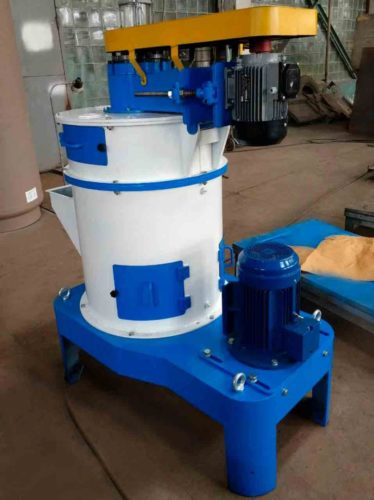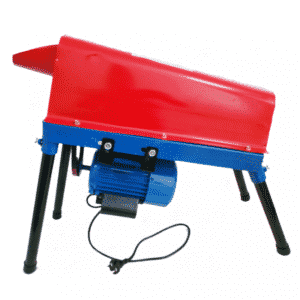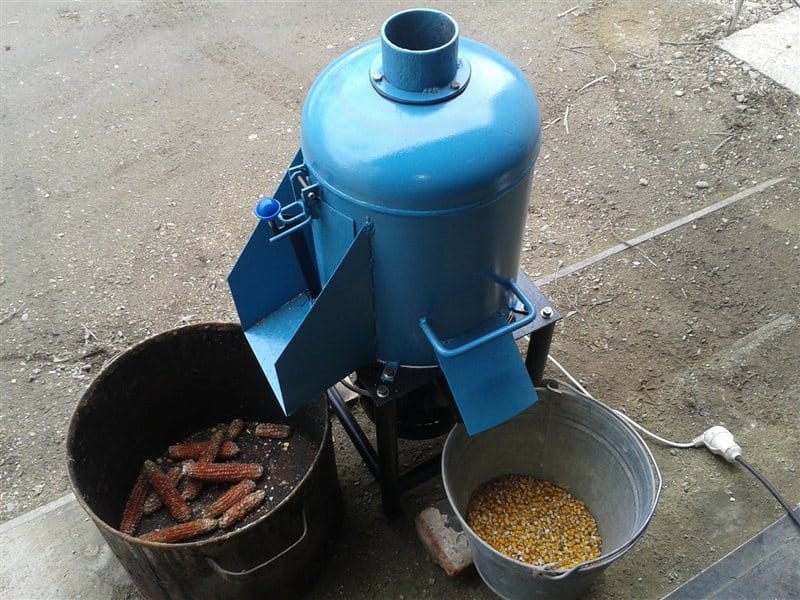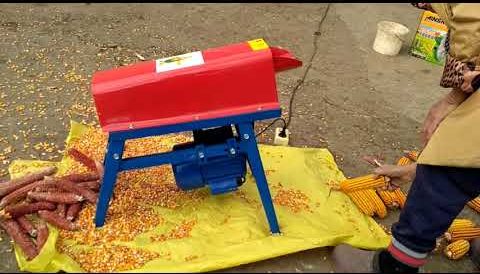What is a corn sheller and how to make it yourself
Corn cobs cannot be stored for long. After harvesting, it is important to process them as quickly as possible. Husking large quantities of corn by hand is a tedious and monotonous task. To speed up the process and save effort, special devices are used. You can buy a corn sheller or make it yourself.
What is a corn sheller and what types are they?
Unhusked corn is not stored for a long time. In this form, until spring, the entire harvest will turn into a breeding ground for insects and fungi, which will completely spoil the grain.
Unpeeled cobs take up much more space, which is often important in small farms. Therefore, the peeler (puller) is considered an indispensable device.
There are 2 main types of such devices:
- Industrial.
- Amateur.
The former are capable of processing up to 500 kg of cobs in 1 hour. These are large units that require 2 people to operate. The bunker has large volumes.

Amateur ones include low-power units. The maximum productivity of such devices is 100 kg in 1 hour.

Corn husker is:
- automatic – works with the help of an electric motor;
- manual – functions thanks to human power.
Components
The design includes several main elements:
- Drum. A container in which the grains are separated from the stalks.The drum has holes for loading raw materials, removing stalks and sifting out purified grain.
- Peeling element. It is fixed to the drum shaft. He produces cleaning grain from stalks.
- Protective cover. Required to protect the rotating elements of the device.
- Container for grain. The purified grain falls into it.
- Drive unit. A structural unit that transmits rotation from the motor to the peeling element.
Operating principle

Most corn shellers have a disk equipped with soft teeth. Their height varies from 5 to 10 mm. The disk also has a large number of round holes for grain.
It is important that the housing be closed with a damper. In this case, the grains will not scatter to the sides. There are also designs that have a cob tray attached to the body. This saves a lot of time: while the first batch is being processed inside the device, the second is waiting in the tray.
First, the crop is placed in a drum. After turning on, the engine begins to rotate the disk at a speed of 450 rpm. Centrifugal force occurs, causing the corn to be pressed against the walls. The teeth catch her. The grain begins to separate from the cobs, after which it spills through the holes of the disk and into the gap located between the disk and the cylinder. This way it gets to the bottom of the device.
After the receiver, the corn is poured through a chute onto the ground or into a prepared container. The peeled cobs are pushed up unpeeled due to the difference in weight. When the grains no longer flow down the chute, the waste is removed and a new batch is loaded.
In small devices, the operating principle is the same, but they have differences in design.A pipe with teeth is attached to a rotating disk. The cob is placed in it, held in the hand, and after cleaning, it is removed independently.
In large devices, the cleaning element is placed horizontally, and in small devices – vertically.
This is interesting:
How to distinguish feed corn from food corn and the scope of application of both types
What are the benefits of corn starch and how is it different from potato starch?
How to make it yourself
A homemade device for shelling corn is the pride of a farmer. Such a device not only fulfills its intended purpose, but also speaks of the ingenuity and thriftiness of its owner.
Self-production allows you to get a unit that will fully meet the requirements put forward by the farmer.
To make a peeler with your own hands, you will need the following tools:
- crosshead screwdriver;
- roulette;
- set of wrenches;
- square;
- carpenter's pencil;
- drill with drills;
- welding machine.
What materials can be used
The container where the grains are separated is considered the main structural element. For its manufacture, barrels, large-diameter pipes, drums from old top-loading washing machines, various metal cylinders, gas cylinders, etc. are used. The main thing is that the thickness of the metal is at least 0.5 mm.
Important! Use extreme caution when using a gas cylinder. It is first cleaned of any remaining fuel, since during cutting it can cause an explosion.
Other materials used in the manufacture of peelers:
- rotation shaft;
- washing machine motor;
- transmission belt;
- a thick metal sheet from which the peeling disk is made;
- steel corners or profile pipe;
- wheels;
- mounting bolts;
Other materials may also be needed. It all depends on the chosen design.
How to make
The easiest way to make a corn sheller is from an old washing machine. The most suitable devices are those that have vertical loading of laundry, for example, the Aurika machine.

Step-by-step algorithm for making a peeler:
- Prepare a round tank. It is taken out of the washing machine, the blades for swirling the water are removed and the lower pipe is cut off. After this, cut off the bottom. If there is no tank, use a regular gas cylinder. The top and bottom parts are cut off to form a cylinder.
- The disk is made of steel 3-4 mm thick. Using a pencil or marker, divide it into several sectors, in which elongated holes 1-2 cm wide are made. Through them, the cleaned grains will fall down.
- The dimensions of the disk are selected so that it is 2 cm smaller than the diameter of the tank. This distance serves the same purpose as the holes in the disk.
- Using bolts or welding, teeth 8 mm long are secured to the disk. The ends must be blunt so that the grain does not break on them.
- The prepared disk is secured to the shaft in the center of the housing.
- The entire device is mounted on legs. Sometimes wheels are additionally attached to them.
- The disk that cleans the cobs is rotated by an electric motor. It is advisable to select its power at 1.5 kW. Engine rotation speed – 500-600 rpm.
- 2 holes are made in the tank. The first is intended for loading cobs, and the second is for collecting clean grain.
- It is advisable to provide a damper in the bunker. It will help save a lot of time when dealing with large volumes of work.After one batch has been processed, the shutter is opened and the process continues immediately.
- After this, a test run of the installation is performed.
Tips and tricks for making

Basic recommendations that are followed when making a peeler:
- It is advisable to prepare a drawing before starting work and carefully consider how all the parts will be secured. This allows you to select all the required material and tools.
- The holes in the tank for feeding cobs and receiving grain are made with doors so that nothing can fly apart.
- It will be more convenient to work if you provide a tray for unhusked corn.
- If the engine is high-power, an emergency power outage is required.
- The hole for removing recycled materials is made so that a bag can be put on it. This device will speed up the work several times.
- To make the device more convenient to transport, small wheels are attached to it.
Conclusion
A corn sheller is a very useful device on the farm. Making a homemade installation does not require much time or money. It is done in one day. The main thing is to think through the design in advance, select drawings and prepare all the required materials.